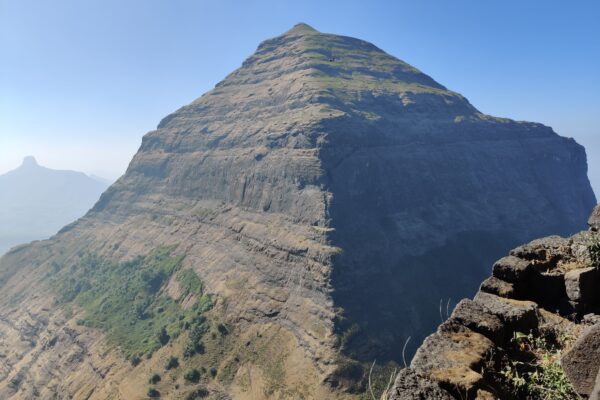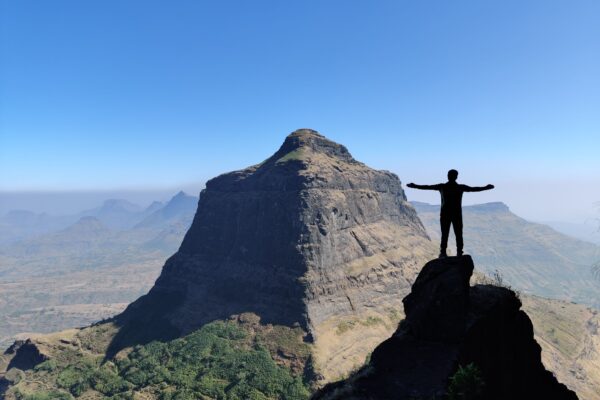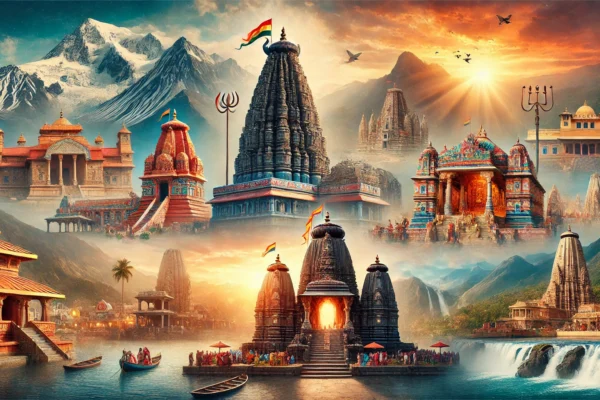
Category: Travel

How to Trek Salher Fort and Salota Fort: A Complete Guide
Maharashtra is home to some of India’s most incredible and historic forts, with Salher and Salota standing as two of the most iconic. These twin forts, nestled in the Selbari-Dolbari hill ranges near the Maharashtra-Gujarat border, offer an exhilarating trekking experience and a fascinating glimpse into Maratha history. Standing tall at 5,175 feet, Salher Fort holds the title of the highest fort in Maharashtra, while the adjacent Salota Fort is known for its strategic vantage point. If you’re looking for an unforgettable trek through Maharashtra’s historic forts, the Salher-Salota trek is a must-do. This trek blends historical exploration, breathtaking views, and challenging trails, making it a truly unforgettable adventure. Let’s dive into all the details about this iconic trek—from its rich history and stunning views to trail specifics and preparation tips. Table of Contents Why Trek the Salher-Salota Forts? The Salher-Salota trek offers a combination of breathtaking natural beauty and a deep connection to Maharashtra’s Maratha heritage. Reasons to Trek Salher-Salota The Battle of Salher: A Historic Maratha Victory In 1672, the Maratha Empire achieved a historic milestone—the Battle of Salher, where they secured their first open-field victory against the Mughal Empire. This battle, fought in the shadow of Salher Fort, marked a turning point in Maratha history, giving the trek a unique historical importance. Salher Fort played a crucial role in the Maratha defense. Its pyramid-like structure, surrounded by steep slopes, provided a defensive advantage. Today, trekking Salher is about walking in the footsteps of these warriors and experiencing the remnants of their legacy. What to Expect on the Salher-Salota Trek Salher Fort: The Highest Fort of Maharashtra Salota Fort: A Strategic Maratha Outpost Both forts are nestled in the rugged Sahyadri mountains, separated by a ridge (col), making it easy to view Salota from Salher and vice versa. Trail Details and Trek Itinerary The Salher-Salota Fort trek usually takes two days, combining moderate challenges with rewarding views and rich historical exploration. This itinerary allows ample time for exploration and an overnight stay on Salher Fort. Here’s a detailed itinerary to help you plan: Day 1: Waghambe Village to Salher Fort Day 2: Salher Fort to Salota Fort Best Time to Visit The best time to embark on the Salher-Salota Fort trek is between October and February when the weather is cool and ideal for trekking. How to Reach the Base Villages By Road from Mumbai/Nashik: Public Transport: Packing List and Trekking Essentials Essentials to Carry: Challenges and Safety Precautions The trek is moderately challenging, with some steep sections and rock-cut steps that require careful attention, particularly during monsoon or post-monsoon months. Nearby Attractions If you have extra time, consider visiting other nearby trekking spots: FAQs Q: Do I need permission to trek Salher-Salota? No, permission is not required to trek these forts or camp at the summit. Q: Are there food and water sources available on the trail? There are no restaurants along the trail. You must carry your food and water supplies. There are some potable water cisterns on Salher Fort. Q: What fitness level is required? The trek is suitable for fit beginners and intermediate trekkers. However, the steep ascents and rock-cut steps make it a moderately challenging trek. Embark on this thrilling adventure to experience the beauty and history of Maharashtra’s highest forts—Salher and Salota. This trek is an unforgettable experience for any trekker, combining natural beauty, historical exploration, and the challenge of climbing to new heights.

Top 10 Highest Forts of Maharashtra: A Journey Through History and Adventure
Maharashtra is a land of majestic forts, each standing tall as a testament to the rich history and heroic battles fought by the Marathas. From towering peaks to deep valleys, these forts are not only historically significant but also offer some of the most thrilling trekking experiences. In this guide, we’ll explore the Top 10 Highest Forts of Maharashtra, ranked by their elevation, and dive into the history, significance, and adventure they provide. Whether you’re a history enthusiast, an avid trekker, or someone seeking a thrilling escape into nature, these forts are sure to capture your imagination. 1. Salher Fort – The Highest Fort in Maharashtra Salher Fort is the highest fort in Maharashtra, standing proudly at 5,141 feet. This fort was the site of one of the largest battles between the Marathas and Mughals, making it a historically significant destination. For trekkers, Salher offers a challenging climb with steep, rugged terrain, especially towards the end. Once you reach the top, you’ll be rewarded with stunning panoramic views of the surrounding Sahyadri range, as well as a breathtaking view of the nearby Salota Fort. Why Visit? 2. Salota Fort – The Neighbor to Salher Located close to Salher, Salota Fort stands at 4,900 feet and offers a similarly challenging trek. The fort is less explored compared to Salher, giving trekkers a sense of isolation and tranquility as they explore the ruins and the beautiful landscape around. Why Visit? 3. Harishchandragad Fort – The Thrill of Konkan Kada Harishchandragad Fort is one of the most beautiful and thrilling forts in Maharashtra. Its most famous feature is the Konkan Kada, a cliff that offers stunning views of the surrounding valley. The trek to Harishchandragad is challenging, with steep climbs and rugged terrain that make it ideal for experienced trekkers. The fort also has historical significance, with ancient temples and caves that add to the charm of this destination. Why Visit? 4. Torna Fort – The First Conquest of Shivaji Maharaj Torna Fort, also known as Prachandagad, is one of the most significant forts in Maharashtra. It was the first fort captured by Chhatrapati Shivaji Maharaj at the age of 16, marking the beginning of the Maratha Empire. The fort offers sweeping views of the Sahyadri range, especially during the monsoon season when the surrounding area is lush with greenery. The trek to Torna is moderate to difficult, making it an exciting challenge for adventure enthusiasts. Why Visit? 5. Rajgad Fort – The Former Capital of the Maratha Empire Rajgad Fort was once the capital of the Maratha Empire under Chhatrapati Shivaji Maharaj and is known for its sprawling size and historical significance. The trek to Rajgad is challenging but incredibly rewarding, offering stunning views of the surrounding mountains. The fort itself is vast, with various points of interest such as Padmavati Temple, Suvela Machi, and Balekilla, which provide a glimpse into the grandeur of the Maratha Empire. Why Visit? 6. Ratangad Fort – The Jewel of the Sahyadris Ratangad Fort is known for its scenic beauty and its strategic location in the Sahyadris. The fort offers a thrilling trek through rocky terrain and lush forests. The fort’s natural rock formations, especially the Nedhe or “needle hole,” are a highlight for many visitors. Why Visit? 7. Panhala Fort – The Largest Fort in Maharashtra Panhala Fort is one of the largest forts in Maharashtra, known for its rich history and stunning architecture. The fort was an important strategic location during Shivaji Maharaj’s reign and offers a relatively easy trek compared to some of the other forts on this list. Why Visit? 8. Lohagad Fort – The Iron Fort Lohagad Fort is known for its unique Vinchu Kata (Scorpion’s Tail), a long and narrow ridge that extends from the fort and offers stunning views of the surrounding region. The fort is one of the easiest to trek and is perfect for beginners. Why Visit? 9. Pratapgad Fort – The Victory Fort Pratapgad Fort is famous for the historic battle between Shivaji Maharaj and Afzal Khan. The fort offers stunning views of the nearby hills and valleys, making it a popular destination for trekkers and history enthusiasts. Why Visit? 10. Shivneri Fort – The Birthplace of Shivaji Maharaj Shivneri Fort is the birthplace of Chhatrapati Shivaji Maharaj, making it a significant historical site. The trek to Shivneri is relatively easy, making it accessible for beginners, and the fort offers panoramic views of the surrounding area. Why Visit? Conclusion Maharashtra’s forts offer a unique blend of history, adventure, and natural beauty. From the highest fort at Salher to the historically significant

Top 10 Wildlife Sanctuaries in India for an Unforgettable Safari Experience
India, with its diverse ecosystems and rich biodiversity, is home to some of the most stunning wildlife sanctuaries in the world. Whether you’re a wildlife enthusiast, nature lover, or simply someone looking to escape the city, India’s wildlife sanctuaries offer an unforgettable safari experience. From tigers to elephants, and from rare birds to scenic landscapes, here are the top 10 wildlife sanctuaries in India that you must visit: 1. Jim Corbett National Park, Uttarakhand Best Known For: Bengal Tigers, Leopards, and Elephants Best Time to Visit: November to June Jim Corbett National Park is India’s oldest and most famous wildlife sanctuary. Spread across the foothills of the Himalayas, it offers lush forests, riverine belts, and grasslands. The park is home to over 500 species of animals and birds, making it a paradise for wildlife photographers. Fun Fact: The park is named after the legendary hunter-turned-conservationist Jim Corbett. 2. Ranthambore National Park, Rajasthan Best Known For: Bengal Tigers Best Time to Visit: October to April One of the largest national parks in northern India, Ranthambore is famous for its tiger sightings. The park’s unique blend of history and nature makes it a popular tourist destination. Ancient ruins, palaces, and the majestic Ranthambore Fort add to its charm. Pro Tip: Early morning safaris are the best for spotting tigers in action. 3. Kaziranga National Park, Assam Best Known For: One-Horned Rhinoceros Best Time to Visit: November to April A UNESCO World Heritage Site, Kaziranga is a dream destination for wildlife lovers. Famous for the largest population of the one-horned rhinoceros, the park is also home to elephants, tigers, and water buffaloes. Its vast grasslands and marshlands provide the perfect habitat for various species. Don’t Miss: Take a boat safari along the Brahmaputra River for a unique wildlife experience. 4. Sundarbans National Park, West Bengal Best Known For: Bengal Tigers, Crocodiles, and Mangrove Forests Best Time to Visit: November to March The Sundarbans is one of the largest mangrove forests in the world and a UNESCO World Heritage Site. It is the only place in the world where tigers are known to swim in tidal rivers. The park is also home to saltwater crocodiles, wild boars, and hundreds of bird species. Pro Tip: Opt for a boat safari to explore the unique ecosystem of the Sundarbans. 5. Bandhavgarh National Park, Madhya Pradesh Best Known For: Bengal Tigers, Leopards Best Time to Visit: October to June Bandhavgarh is known for having the highest density of Bengal tigers in India. The park also boasts a rich history, with ancient caves and temples scattered across the region. The lush landscape, dense forests, and rolling hills create a perfect environment for wildlife spotting. Fun Fact: Bandhavgarh was once the hunting ground of the Maharajas of Rewa. 6. Periyar Wildlife Sanctuary, Kerala Best Known For: Elephants, Tigers, and Rich Flora Best Time to Visit: September to April Nestled in the Western Ghats, Periyar is a beautiful wildlife sanctuary that offers more than just animal sightings. Its serene lakes, lush forests, and picturesque landscapes make it ideal for nature lovers. The sanctuary is famous for its elephant herds, and you can often spot them near the lake. Tip: Try the bamboo rafting experience in the heart of the sanctuary for a unique adventure. 7. Gir National Park, Gujarat Best Known For: Asiatic Lions Best Time to Visit: December to April Gir is the only place in the world where you can spot the endangered Asiatic lions in their natural habitat. The park’s rugged terrain, dry deciduous forests, and savannah-like grasslands provide the perfect environment for these majestic creatures. Fun Fact: The Gir Forest was once the private hunting grounds of the Nawabs of Junagadh. 8. Pench National Park, Madhya Pradesh Best Known For: Tigers, Leopards, and Wildlife Safaris Best Time to Visit: November to May Pench National Park served as the inspiration for Rudyard Kipling’s famous novel “The Jungle Book.” The park’s lush forests, streams, and rivers provide a rich habitat for tigers, leopards, and several herbivore species. Jeep safaris offer thrilling encounters with wildlife. Pro Tip: Evening safaris offer the best chance to see predators in action. 9. Nagarhole National Park, Karnataka Best Known For: Tigers, Elephants, and Leopards Best Time to Visit: October to May Part of the Nilgiri Biosphere Reserve, Nagarhole is one of the best places in India to spot elephants and tigers. The park’s dense forests, riverine systems, and waterfalls make it a scenic destination for wildlife lovers. Don’t Miss: Combine your trip with a visit to nearby Kabini, known for its luxurious wildlife lodges. 10. Satpura National Park, Madhya Pradesh Best Known For: Tigers, Sloth Bears, and Leopards Best Time to Visit: October to April Satpura offers a unique wildlife experience with options like walking safaris and canoeing. The rugged terrain, plateaus, and sandstone peaks make it a scenic and adventurous destination. Tigers, sloth bears, and leopards are commonly sighted here, along with a rich variety of bird species. Pro Tip: Try a walking safari for a unique, closer, more intimate experience with the wildlife. Conclusion India’s wildlife sanctuaries are not only a haven for animals but also offer a tranquil escape for humans seeking a connection with nature. Whether you’re tracking a tiger, spotting a herd of elephants, or simply enjoying the beautiful landscapes, these sanctuaries are a must-visit for anyone with a love for wildlife. Call to Action: Ready to embark on your wildlife adventure? Pack your bags, grab your camera, and head to one of these amazing sanctuaries for a once-in-a-lifetime experience!

Discover the 12 Sacred Jyotirlingas of India: A Spiritual Journey
Somnath Jyotirlinga Prabhas Patan, Gujarat Somnath Temple, Somnath Mandir Rd, Veraval, Gujarat 362268 The Somnath Temple is the first of the twelve Jyotirlingas and is located on the western coast of Gujarat. Known as the “Shrine Eternal,” it has been destroyed and rebuilt several times, symbolizing resilience. Somnath is revered for being the place where Lord Krishna ended his earthly avatar. Mallikarjuna Jyotirlinga Srisailam, Andhra Pradesh Mallikarjuna Temple, Srisailam, Andhra Pradesh 518101 Nestled in the Nallamala Hills, the Mallikarjuna Temple is a tranquil place where Lord Shiva and Goddess Parvati are believed to have manifested. It is a site of great spiritual significance and offers breathtaking views of the surrounding forest. Mahakaleshwar Jyotirlinga Ujjain, Madhya Pradesh Mahakaleshwar Temple, Jaisinghpura, Ujjain, Madhya Pradesh 456006 Mahakaleshwar is one of the most revered Jyotirlingas and is located in Ujjain, known for its powerful energy. The temple is famous for its Bhasma Aarti, performed daily before sunrise, where the Lord is worshipped with sacred ash. Omkareshwar Jyotirlinga Omkareshwar, Khandwa District, Madhya Pradesh Omkareshwar Temple, Omkareshwar, Madhya Pradesh 450554 Situated on the sacred island in the shape of ‘Om,’ Omkareshwar Temple holds immense religious significance. The island is located on the confluence of the Narmada and Kaveri rivers, adding to its spiritual charm. Kedarnath Jyotirlinga Kedarnath, Uttarakhand Kedarnath Temple, Kedarnath, Uttarakhand 246445 Kedarnath Temple is nestled high in the Himalayas and is accessible only during certain months due to heavy snowfall. It is one of the most revered pilgrimages and is considered the home of Lord Shiva in his Kedarnath form. Bhimashankar Jyotirlinga Pune, Maharashtra Bhimashankar Temple, Bhorgiri, Pune, Maharashtra 410509 Set amidst the Sahyadri Hills, Bhimashankar is a beautiful pilgrimage spot known for its natural beauty and the ancient temple architecture. It is surrounded by dense forests, making it a perfect place for spiritual solitude. Kashi Vishwanath Jyotirlinga Varanasi, Uttar Pradesh Kashi Vishwanath Temple, Varanasi, Uttar Pradesh 221001 Kashi Vishwanath Temple, located in the sacred city of Varanasi, is one of the most revered pilgrimage destinations in India. Lord Shiva is believed to grant moksha (salvation) to his devotees here. Trimbakeshwar Jyotirlinga Nashik, Maharashtra Trimbakeshwar Temple, Trimbak, Nashik, Maharashtra 422212 Trimbakeshwar is located near the origin of the holy river Godavari. This Jyotirlinga is unique as it represents the trinity of Lord Brahma, Lord Vishnu, and Lord Shiva. The temple is also an important center for various Vedic rituals like Narayan Nagbali and Tripindi Shraddha. Vaidyanath Jyotirlinga Deoghar, Jharkhand Baba Baidyanath Dham, Deoghar, Jharkhand 814112 Also known as Baba Baidyanath, this temple is considered one of the most sacred abodes of Lord Shiva. It is believed that Ravana worshipped Lord Shiva here and offered his ten heads, thus the deity is also referred to as ‘Vaidyanath,’ the Lord of healing. Nageshwar Jyotirlinga Dwarka, Gujarat Nageshwar Jyotirlinga Temple, Dwarka, Gujarat 361345 Situated near Dwarka, Nageshwar is one of the twelve Jyotirlingas and is considered a symbol of protection from all poisons. It is believed that Lord Shiva in this form protects his devotees from negativity and evil. Rameshwaram Jyotirlinga Rameshwaram, Tamil Nadu Ramanathaswamy Temple, Rameshwaram, Tamil Nadu 623526 Rameshwaram Jyotirlinga is one of the most sacred Hindu pilgrimage destinations. It is believed that Lord Rama worshipped Lord Shiva here to absolve his sins after the war against Ravana. The temple’s intricate architecture and long corridors make it one of the finest in India. Grishneshwar Jyotirlinga Aurangabad, Maharashtra Grishneshwar Temple, Ellora, Aurangabad, Maharashtra 431102 Grishneshwar Temple is located near the famous Ellora Caves and is the twelfth Jyotirlinga. This temple is revered for its simplicity and its importance in Hindu mythology. It is said to be the last Jyotirlinga on earth.

